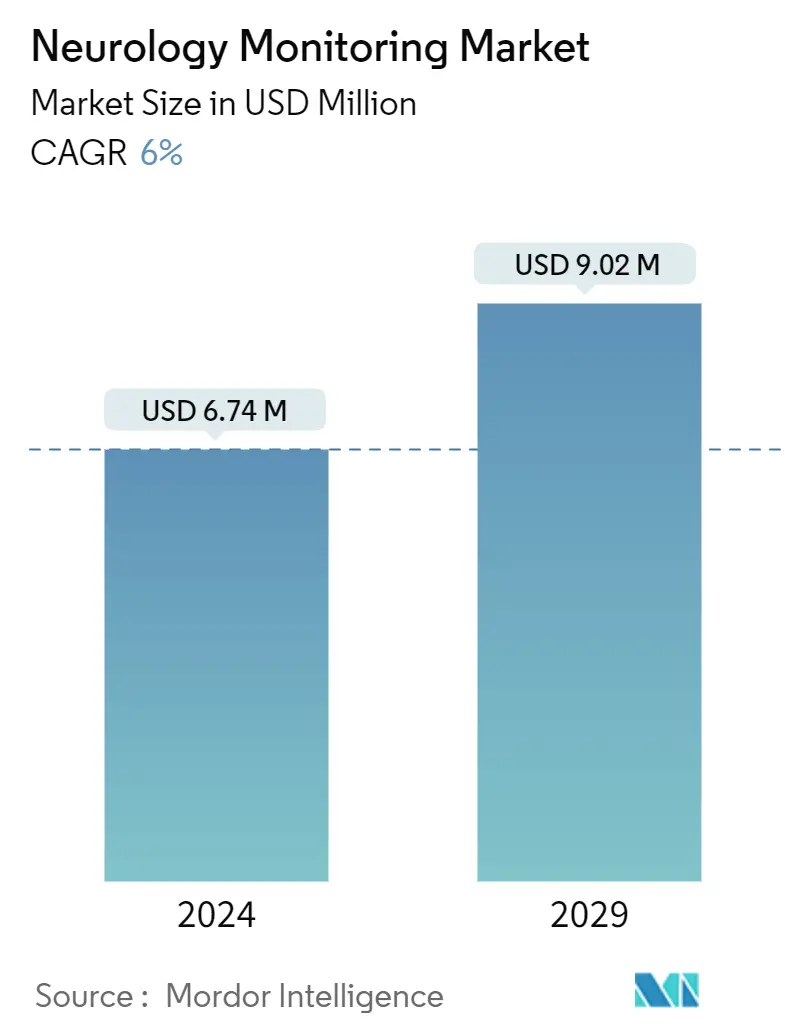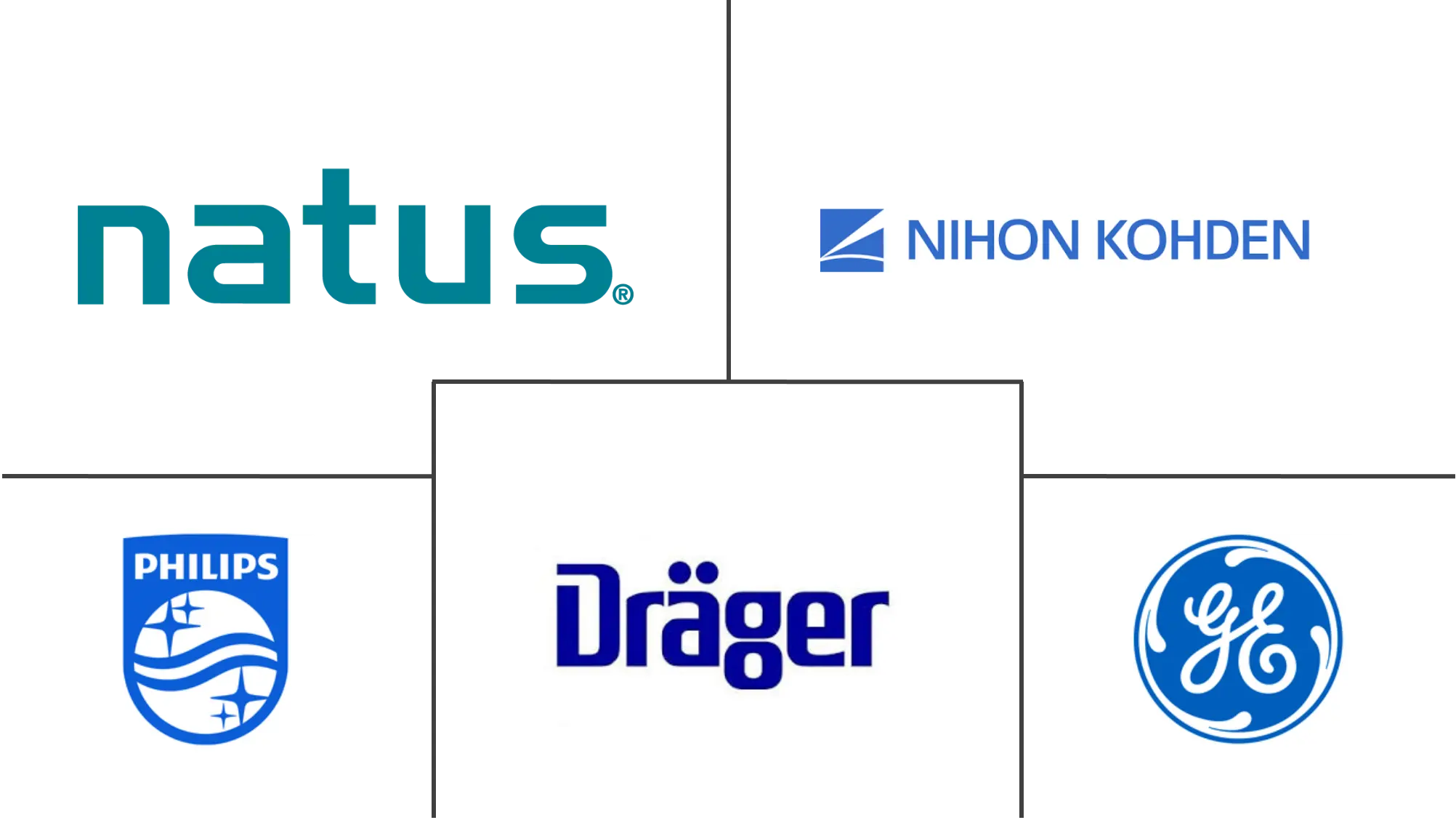Market Size of Neurology Monitoring Industry

| Study Period | 2019 - 2029 |
| Market Size (2024) | USD 6.74 Million |
| Market Size (2029) | USD 9.02 Million |
| CAGR (2024 - 2029) | 6.00 % |
| Fastest Growing Market | Asia Pacific |
| Largest Market | North America |
| Market Concentration | Medium |
Major Players
*Disclaimer: Major Players sorted in no particular order |
Neurology Monitoring Market Analysis
The Neurology Monitoring Market size is estimated at USD 6.74 million in 2024, and is expected to reach USD 9.02 million by 2029, growing at a CAGR of 6% during the forecast period (2024-2029).
COVID-19 had a profound impact on people with neurological disorders. Owing to the pandemic-related restrictions, diagnostics and treatment procedures were impacted, and research activities were halted. For instance, the National Institute of Health data published in April 2021 stated that the estimated incidence of a neurological or psychiatric diagnosis in the initial six months of the COVID-19 pandemic was 33.62% among the 236,379 patients diagnosed with COVID-19. Among those diagnosed, 0.56% suffered from intracranial hemorrhage, 2.10% from ischemic stroke, 0.11% from parkinsonism, 0.67% from dementia, 17.39% from an anxiety disorder, and 1.40% from a psychotic disorder. Therefore, with the abovementioned data, it was observed that COVID-19 significantly impacted the market studied. However, the market is gaining its pre-pandemic demand for neurology monitoring devices, and it is expected to witness healthy growth in the forecast period.
The major drivers for the market growth are the increasing burden of neurological disorders, the growing incidence of traumatic brain injuries, and the increasing number of product approvals. For instance, according to a WHO article published in February 2023, an estimated 5 million people are diagnosed with epilepsy every year globally. Also, per the Indian Head Injury Foundation's 2022 data, over one million head injuries occur annually in India. Therefore, the high burden of neurological disorders such as epilepsy and many head injuries is accelerating the demand for neurology monitoring devices.
The strategic initiatives by market players, such as product launches, approvals, partnerships, and expansions, are also contributing to the growth of the neurological monitoring market. For instance, in February 2022, Masimo's brain-monitoring headset received FDA approval for pediatric use. The SedLine sensors and monitoring system have now been adapted to fit children between the ages of 1 and 17. The system helps physicians monitor brain activity while patients are sedated, detecting signs of potential reactions to the anesthesia. Such advancements and rising approvals are projected to boost the demand for neurology monitoring devices.
Therefore, owing to the factors above, such as the high prevalence of neurological diseases and strategic initiatives adopted by market players, the studied market is anticipated to grow over the analysis period. However, the high cost of monitoring devices is expected to restrain the market growth in emerging economies.
Neurology Monitoring Industry Segmentation
As per the scope of the report, neurology monitoring devices are used to monitor and diagnose neurological conditions by exploring the structure and function of the brain. This process involves using several brain-monitoring devices to track and monitor brain functions. In addition, these devices help monitor neural and electrical activity in the brain. The Neurology Monitoring Market is Segmented by Product Type (Magnetic Resonance Imaging (MRI) Devices, Electroencephalography devices, Cerebral Oximeters, Intracranial Pressure Monitors, Other Product Types), Disease Type (Traumatic Brain Injury (TBI), Stroke, Sleep Disorders, Parkinson's Disease, Epilepsy, Other Diseases), and Geography (North America, Europe, Asia-Pacific, Middle East & Africa, South America). The report also covers the estimated market sizes and trends for 17 countries across major regions globally. The report offers the value in USD for the above segments.
| By Product Type | |
| Magnetic Resonance Imaging (MRI) Devices | |
| Electroencephalography devices | |
| Cerebral Oximeters | |
| Intracranial Pressure Monitors | |
| Other Product Types |
| By Disease Type | |
| Traumatic Brain Injury (TBI) | |
| Stroke | |
| Sleep Disorders | |
| Parkinson's Disease | |
| Epilepsy | |
| Other Disease Types |
| By Geography | ||||||||
| ||||||||
| ||||||||
| ||||||||
| ||||||||
|
Neurology Monitoring Market Size Summary
The neurology monitoring market is poised for significant growth over the forecast period, driven by the increasing prevalence of neurological disorders and traumatic brain injuries. The market is recovering from the disruptions caused by the COVID-19 pandemic, which had a notable impact on the diagnosis and treatment of neurological conditions. The demand for neurology monitoring devices is being fueled by the high incidence of disorders such as epilepsy and the rising number of product approvals. Strategic initiatives by key market players, including product launches and partnerships, are further propelling market expansion. Despite the high cost of monitoring devices posing a challenge in emerging economies, the overall market outlook remains positive.
North America is expected to be a major contributor to the market's growth, supported by favorable reimbursement policies, high healthcare spending, and a growing geriatric population susceptible to neurodegenerative disorders. The region's high prevalence of sleep disorders, such as insomnia, is also driving demand for neurology monitoring solutions. The market is characterized by moderate competition and fragmentation, with major players like Natus Medical Inc., Philips, and GE Healthcare focusing on research and development to innovate and reduce costs. Initiatives like the development of low-cost, non-invasive monitoring devices are indicative of the market's commitment to advancing technology and improving patient outcomes.
Neurology Monitoring Market Size - Table of Contents
-
1. MARKET DYNAMICS
-
1.1 Market Overview
-
1.2 Market Drivers
-
1.2.1 Increasing Burden of Neurological Disorders
-
1.2.2 Growing Incidence of Traumatic Brain Injuries
-
1.2.3 Increasing Number of Product Approvals
-
-
1.3 Market Restraints
-
1.3.1 High Cost of Monitoring Devices
-
1.3.2 Shortage of Trained Professionals
-
-
1.4 Porter's Five Forces Analysis
-
1.4.1 Bargaining Power of Buyers/Consumers
-
1.4.2 Bargaining Power of Suppliers
-
1.4.3 Threat of New Entrants
-
1.4.4 Threat of Substitute Products
-
1.4.5 Intensity of Competitive Rivalry
-
-
-
2. MARKET SEGMENTATION (Market Size - Value in USD)
-
2.1 By Product Type
-
2.1.1 Magnetic Resonance Imaging (MRI) Devices
-
2.1.2 Electroencephalography devices
-
2.1.3 Cerebral Oximeters
-
2.1.4 Intracranial Pressure Monitors
-
2.1.5 Other Product Types
-
-
2.2 By Disease Type
-
2.2.1 Traumatic Brain Injury (TBI)
-
2.2.2 Stroke
-
2.2.3 Sleep Disorders
-
2.2.4 Parkinson's Disease
-
2.2.5 Epilepsy
-
2.2.6 Other Disease Types
-
-
2.3 By Geography
-
2.3.1 North America
-
2.3.1.1 United States
-
2.3.1.2 Canada
-
2.3.1.3 Mexico
-
-
2.3.2 Europe
-
2.3.2.1 Germany
-
2.3.2.2 United Kingdom
-
2.3.2.3 France
-
2.3.2.4 Italy
-
2.3.2.5 Spain
-
2.3.2.6 Rest of Europe
-
-
2.3.3 Asia-Pacific
-
2.3.3.1 China
-
2.3.3.2 Japan
-
2.3.3.3 India
-
2.3.3.4 Australia
-
2.3.3.5 South Korea
-
2.3.3.6 Rest of Asia-Pacific
-
-
2.3.4 Middle East and Africa
-
2.3.4.1 GCC
-
2.3.4.2 South Africa
-
2.3.4.3 Rest of Middle East and Africa
-
-
2.3.5 South America
-
2.3.5.1 Brazil
-
2.3.5.2 Argentina
-
2.3.5.3 Rest of South America
-
-
-
Neurology Monitoring Market Size FAQs
How big is the Neurology Monitoring Market?
The Neurology Monitoring Market size is expected to reach USD 6.74 million in 2024 and grow at a CAGR of 6% to reach USD 9.02 million by 2029.
What is the current Neurology Monitoring Market size?
In 2024, the Neurology Monitoring Market size is expected to reach USD 6.74 million.

